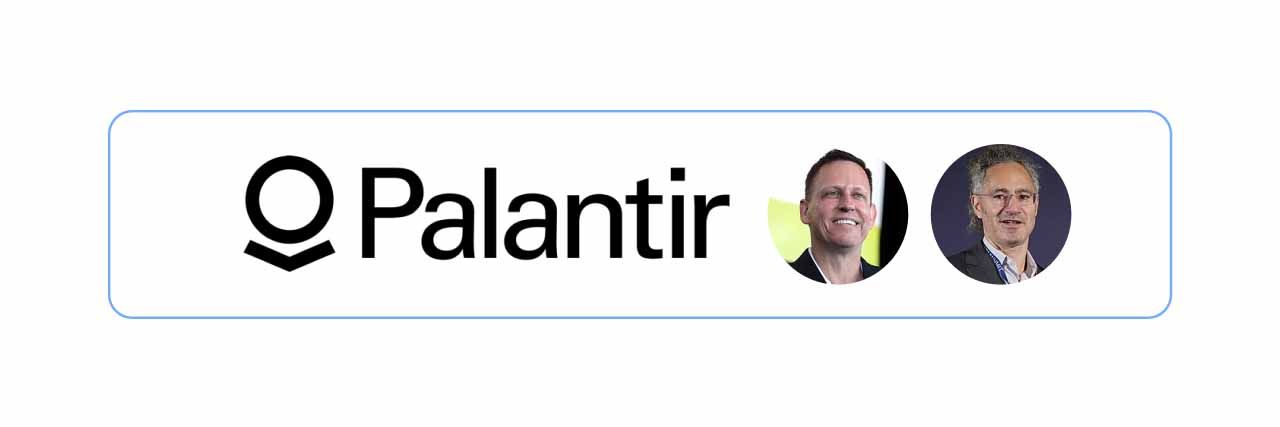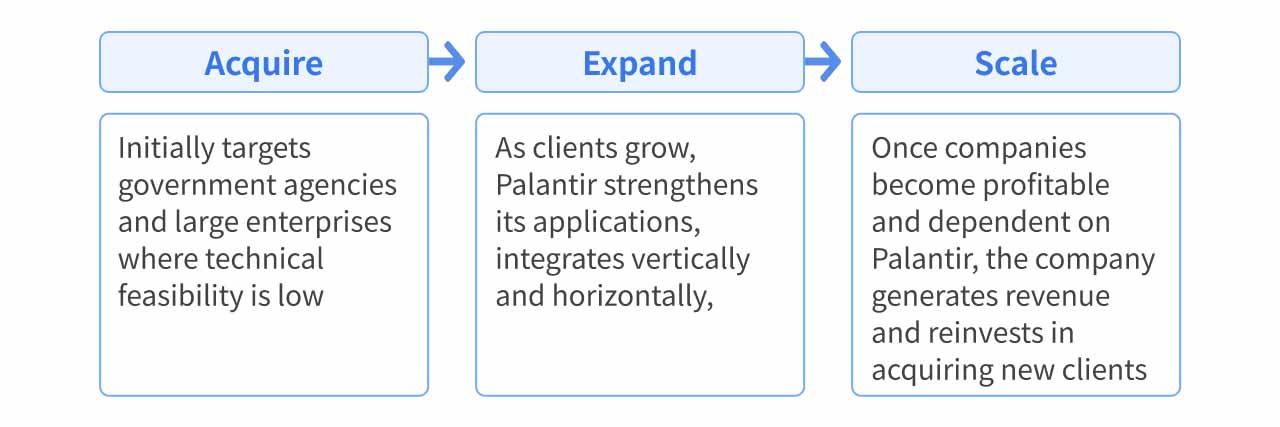On February 3, Palantir released its Q4 2024 earnings report after market close, exceeding expectations with $828 million in revenue, well above the projected $700 million. The 36% year-over-year growth was particularly impressive, with U.S. government revenue increasing by 45%, drawing significant market attention. Following this strong performance, Palantir’s stock surged, and its valuation climbed rapidly, reflecting high investor confidence in the company’s future.
As one of the fastest-growing tech firms today, this article will explore Palantir’s business model, competitive strengths, and potential risks, offering an in-depth look at one of the most promising AI-driven stocks on the market.
Company Overview

Palantir Technologies (NASDAQ: PLTR) is a software company founded in 2004 by Peter Thiel, Alex Karp, and others. Initially focused on big data analytics for U.S. government intelligence agencies, Palantir has expanded its services in recent years to private enterprises, helping businesses with data-driven decision-making.
Palantir’s primary revenue source is the U.S. government, with collaborations extending from defense and national security to immigration management, disaster response, and pandemic control. The company has played a crucial role in major government operations, including the 2009 Madoff Ponzi scheme investigation and the 2011 raid on Osama bin Laden.
Riding the AI boom, Palantir delivered better-than-expected Q4 2024 results, with its market value quadrupling in less than a year. As of February 2025, Palantir’s market cap has surpassed $260 billion.
Business Model

Palantir’s customer acquisition strategy follows a three-phase approach: Acquire → Expand → Scale.
- Acquire: Initially targets government agencies and large enterprises where technical feasibility is low, absorbing early-stage costs to differentiate itself from competitors.
- Expand: As clients grow, Palantir strengthens its applications, integrates vertically and horizontally, and increases customer reliance.
- Scale: Once companies become profitable and dependent on Palantir’s services, the company generates revenue and reinvests in acquiring new clients—creating a self-sustaining growth cycle.
Focusing on the product itself, integration and privacy are Palantir’s two key advantages compared to other software service providers. Traditionally, enterprise data has been stored in isolated systems across different departments, lacking cross-accessibility, resulting in data silos. Palantir consolidates data from various sources and formats into a single platform, transforming it into visualized and easily interpretable insights while ensuring privacy protection. This significantly reduces the complexity of data processing and conversion, while real-time data access enhances operational efficiency. Additionally, Palantir prioritizes data security, implementing access control, encryption, and threat detection systems to safeguard sensitive information—making it the preferred choice for both government agencies and enterprise clients.
Business Segments
According to Palantir’s Q3 2024 earnings report, revenue breakdown is as follows:
| Q3 2024 Revenue ($B) | Q3 2024 Share (%) | Q3 2023 Share (%) | |
|---|---|---|---|
| Government | 4.08 | 56.2 | 55.1 |
| U.S. Government | 3.2 | 44.1 | 41.1 |
| Commercial | 3.17 | 43.7 | 44.9 |
| Total | 7.26 | 100 | 100 |
Revenue by region:
| Q3 2024 Revenue ($B) | Share (%) | |
|---|---|---|
| United States | 4.99 | 69 |
| United Kingdom | 0.69 | 10 |
| Rest of the world | 1.57 | 21 |
| Total | 7.26 | 100 |
Data Sources: SEC PLTR 2024 Q3 10-Q
Palantir’s primary revenue source is government contracts, with the U.S. government accounting for the largest share, and this proportion continues to grow.
Palantir's core business revolves around its two flagship platforms, Gotham and Foundry, with Apollo managing backend operations. Compared to competitors, Palantir offers highly customized applications and has recently developed AIP (Artificial Intelligence Platform) to enhance decision-making efficiency through AI.
Below is a detailed breakdown of Palantir’s four main products, including their positioning and service offerings:
| Position | Clients | Industry | Functionality | |
|---|---|---|---|---|
| Gotham | Software | Defense Department | Defense, Intelligence | Palantir’s flagship government platform, used for intelligence gathering, surveillance, and real-time battlefield analysis. Gotham integrates data from multiple sources (e.g., satellites, surveillance systems) and provides AI-powered mission planning. Recently, Gotham added mixed reality, edge computing, and AI-driven decision support for enhanced strategic operations. |
| Foundry | Software | Governments & Corporates | Finance, Healthcare | Foundry consolidates structured and unstructured data across industries, offering real-time analytics. Its open architecture allows organizations to customize workflows, making it a versatile tool for data-driven decision-making. |
| Apollo | Deployment Management Backend | Software Developers | Apollo serves as Palantir’s SaaS backend, managing Gotham and Foundry. With automated CI/CD (Continuous Integration & Deployment), it ensures secure and scalable software updates. | |
| AIP (Artificial Intelligence Platform) | Generative AI Assistance | Enterprise Users | AIP integrates LLMs (Large Language Models) and generative AI to analyze large datasets, generate insights, and automate workflows. It functions as an AI-powered consultant, assisting users in decision-making while ensuring strict regulatory compliance. |
Competitive Advantages
1. Data Integration
Palantir’s Ontology technology provides structured knowledge representation, enabling seamless data unification from multiple sources. This technology is particularly crucial for AI-driven decision-making, where data connectivity determines success.
2. Data Visualization
Palantir places strong emphasis on data visualization, making it a core feature of its platform. The platform provides powerful visualization tools that transform complex data analysis into intuitive and easily understandable charts, maps, and graphics. This enables non-technical users to interpret data effortlessly and actively participate in data-driven decision-making.
3. AI-Powered Automation
Palantir's platform is more than just a data analytics tool—it has evolved to include AI intelligent agents. Its Artificial Intelligence Platform (AIP) allows enterprises to deploy large language models (LLMs) and advanced AI technologies within private networks, enabling automation and intelligent business processes.
These AI agents can autonomously handle complex tasks, such as monitoring supply chains, optimizing production workflows, and predicting potential risks.
By integrating AI agents with its low-code/no-code capabilities, Palantir aims to streamline workflow automation, making AI-powered decision-making accessible to businesses with minimal technical expertise—significantly enhancing operational efficiency.
Challenges & Risks
Heavy Reliance on Government Contracts
Palantir’s close ties with the government are a double-edged sword. Since defense operations often involve classified information, Palantir provides highly customized solutions in this sector, increasing switching costs for government clients. Its long-term focus on defense has helped build strong trust with government agencies.
This long-term collaboration model ensures stable revenue, as government contracts are typically long-term and have high renewal rates. However, Palantir’s heavy reliance on the U.S. government makes its business vulnerable to political shifts. Additionally, its close government association could limit expansion opportunities with foreign governments and private enterprises, potentially restricting future growth.
Intense Competition in the Private Sector
| Segment | Palantir’s Position |
|---|---|
| Gotham (Government & Defense) | Well-established and deeply integrated in the U.S. government. |
| Foundry (Enterprise Solutions) | Still in its growth phase, competing with Microsoft Azure, IBM, and other tech giants. |
Compared to its peers, Palantir’s highly customized solutions come with a steep price tag.
- The defense-focused Gotham platform costs $141,000 per core, which is over three times the industry average.
- The Foundry platform, designed for private enterprises, is even more expensive than Gotham, making it affordable only for a limited number of corporations.
Due to these high costs, Palantir primarily collaborates with large enterprises such as JPMorgan Chase and Merck, enabling rapid market penetration and a strong foothold. According to Palantir’s Q4 2024 earnings report, its customer base grew 43% YoY and 13% QoQ, indicating that its current client acquisition strategy is effective. However, investors should closely monitor the company's ability to sustain long-term growth.
Cost Management Challenges
Palantir’s highly customized services also lead to significant R&D expenses. Moving forward, the company faces a major challenge in balancing cost control while maintaining its technological edge. Recently, Palantir has focused on AI-driven applications to further differentiate itself from competitors. Investors should keep an eye on the company’s ongoing innovation efforts to assess its future competitive positioning.
Conclusion
Palantir is renowned for its high-end, customized AI solutions, powered by its Ontology-based data integration and cutting-edge AI automation. For investors, Palantir’s strengths lie in its stable government contracts and growing AI-driven data analytics market. However, its heavy dependence on U.S. government deals and intense private sector competition remain key challenges.
Stay tuned for more updates on the AI software industry as we continue to track Palantir’s growth and innovations!
